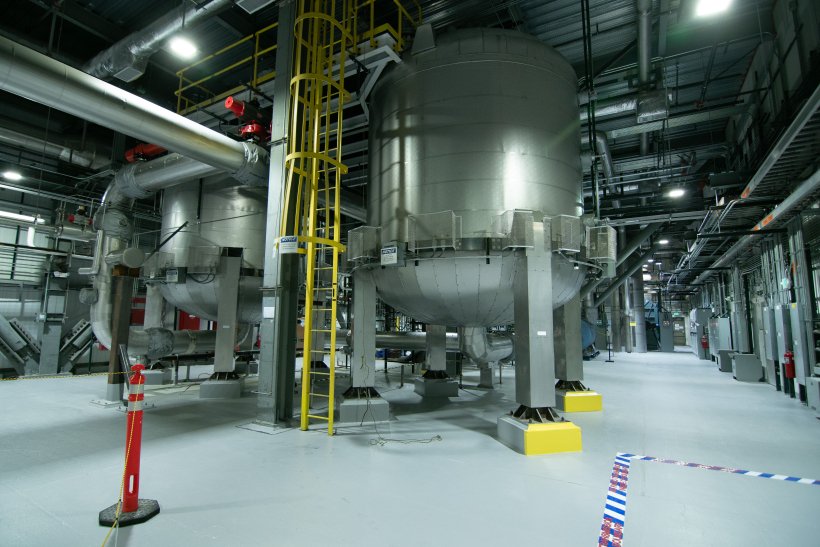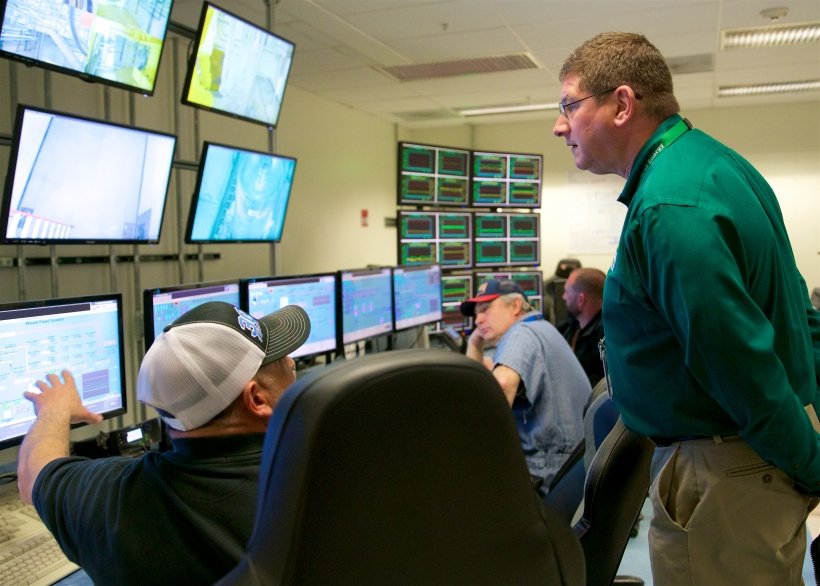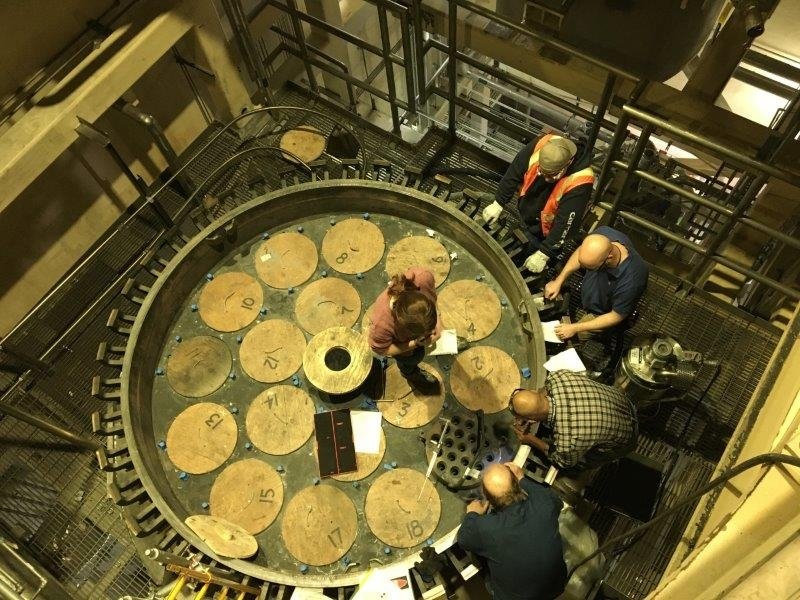IWTU operators monitor radiological operations during the current waste treatment campaign at the Idaho National Laboratory Site facility. (Photo: DOE)
As of last week, crews with Department of Energy cleanup contractor Idaho Environmental Coalition (IEC) processed more than 142,000 gallons of radioactive sodium-bearing tank waste at Idaho’s Integrated Waste Treatment Unit (IWTU) this year.
Crews with the Idaho National Laboratory Site’s IWTU replace filter bundles inside the unit’s process gas filter. (Photo: DOE)
The Department of Energy’s Office of Environmental Management announced yesterday that waste processing operations have resumed at the Integrated Waste Treatment Unit (IWTU) at the Idaho National Laboratory Site. The resumption of operations follows the completion of two maintenance campaigns at the radioactive liquid waste treatment facility.
A view of two vessels that each contain approximately 30,000 pounds of granulated activated carbon, used to remove mercury from process off-gas during IWTU operations. (Photo: DOE)
The Department of Energy’s Office of Environmental Management said Idaho’s Integrated Waste Treatment Unit (IWTU) is set to resume radioactive liquid waste treatment operations early next year after crews replaced carbon material from two plant vessels. The IWTU was shut down for an unplanned outage on September 6 to address elevated mercury concentrations in the plant’s granulated activated carbon (GAC) beds, according to Defense Nuclear Facilities Safety Board (DNFSB) reports.
DOE-EM’s Greg Sosson (standing) views Integrated Waste Treatment activity during the facility’s first day of radiological operations. (Photo: DOE)
After initial runs using a mix of radiological waste and nonradioactive simulant, the Integrated Waste Treatment Unit (IWTU) at the Idaho National Laboratory site has progressed to treating sodium-bearing waste entirely, the Department of Energy’s Office of Environmental Management (DOE-EM) announced on May 22.
DOE-EM officials, IWTU employees, and others signed the first stainless steel canister prior to crews filling it with sodium-bearing waste and simulant. Once filled, that canister and 15 others were placed in a concrete vault for storage. (Photo: DOE)
Since the launch of operations just over a month ago, the Integrated Waste Treatment Unit (IWTU) at Idaho National Laboratory has increased sodium-bearing waste treatment fivefold. This activity is a vital step in removing the remaining liquid waste from nearby underground tanks at the site and protecting the underlying Snake River Plain Aquifer.
The Integrated Waste Treatment Unit at the Idaho National Laboratory Site. (Photo: DOE)
The Department of Energy’s Office of Environmental Management (EM) said that the Integrated Waste Treatment Unit (IWTU), the radioactive liquid waste treatment facility at the Idaho National Laboratory Site, began its final heat-up in December prior to initiating radiological operations, planned for early this year.
IWTU crews were to follow a prescribed incremental process as the facility transitions from simulant to sodium-bearing waste (SBW), according to EM.
Workers inspect the IWTU’s process gas filter before the current confirmatory run. (Photo: DOE)
The Department of Energy’s Office of Environmental Management (EM) said it continues to make progress toward the start of operations of the Idaho National Laboratory Site’s Integrated Waste Treatment Unit (IWTU), having completed a final test run of the facility.
Operation of the IWTU, which was constructed to treat approximately 900,000 gallons of radioactive liquid waste, has been delayed a number of times, most recently due to supply chain issues.
The IWTU liquid nitrogen storage system at the DOE’s Idaho National Laboratory Site. (Photo: DOE)
The Department of Energy’s Office of Environmental Management (EM) stated on February 22 that its Idaho National Laboratory Site contractor is operating the final test run of the Integrated Waste Treatment Unit (IWTU), running waste simulant through the facility to ensure the plant’s performance and personnel proficiency for upcoming radiological operations.







